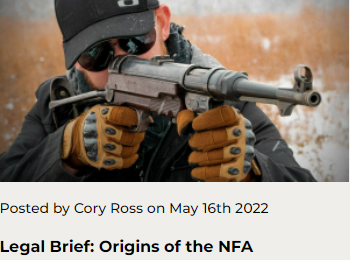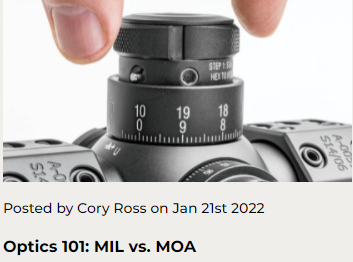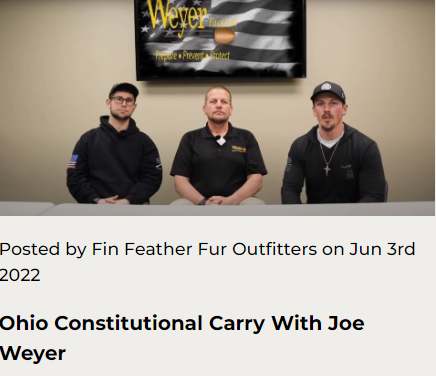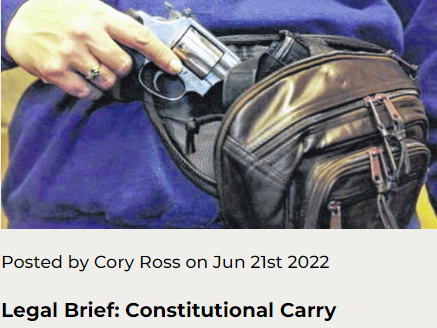Legal Brief: The Supreme Court and the Second Amendment
Posted by Cory Ross on Aug 1st 2022

Overview
Legal Brief is a series where the ins and outs, the dos and don’ts of the firearms world are covered. From popular topics to more niche subject matters, the Legal Brief tries to help our reader be the best gun owner out there. Venture Out is an Ohio based outdoor social channel, so therefore most of our articles, videos, and posts, lean towards that fact. Legal Brief is no exception. The things discussed here are geared towards Ohioans. Please, if residing in a different state, follow all the laws and regulations regarding that state. Furthermore, Venture Out is not legal counsel. So please, if you have further questions, seek the appropriate legal authorities on the subject.
The Supreme Court, the highest court in the Land, recently decided in a 6-3 decision, to strike down New York State Law requiring individuals to show reason when filing for a concealed weapons permit. The Case, New York State Rifle & Pistol Association (NYSRPA) vs. Bruen, was the first case heard in over a decade pertaining to the Second Amendment. This recent decision adds a corollary to the 2008 District of Columbia vs. Heller decision. In this Legal Brief article we deep dive into the implication of this ruling and how it further cements the Second Amendment and an individuals right to self-defense.
Federal vs State
Various states, like here in Ohio, no longer require any form of permit or registration process when it comes to carrying concealed. Now, this isn’t the Wild West; all carriers, whether possessing a license or not, must follow the State’s concealed carry law. However, in restricted states like New York, the people do not have this option. In Ohio, as well as other states, the right to carry for self-defense is as basic of a human right as freedom of speech or freedom of religion. There is this common thought that policing will protect people from the evils of the world. But the reality is, police do not prevent crime. Their presence can help negate it, but law enforcement is always reactionary. It is up to the individual citizen to protect their own life, and the lives of their loved ones. The ruling on New York State Rifle & Pistol Association vs. Bruen further cements that belief to all states. Additionally, this isn’t the first time the Supreme Court has ruled in favor of citizens protecting themselves.
In 2008 the Supreme Court ruled in favor of Heller vs. the District of Columbia. In this case, the Court ruled that the Second Amendment guarantees an individual right to possess firearms independent of service in a state militia and to use firearms for traditionally lawful purposes, including self-defense within the home. The Firearm Controls Regulation Act of 1975 required citizens of the District of Columbia that lawfully owned rifles and shotguns to keep them "unloaded and disassembled or bound by a trigger lock." In its ruling decision, the Court believed that handguns are "arms" for the purposes of the Second Amendment and found that the Regulations Act was an unconstitutional ban. The Court struck down the portion of the Regulations Act that requires all firearms including rifles and shotguns to be kept "unloaded and disassembled or bound by a trigger lock." While this ruling ensured citizens’ ability to defend themselves in their own home, the ruling fell short of self-defense outside of the home. Moreover, the Court also decided that the right to bear arms is not unlimited and that guns and gun ownership would continue to be regulated. In summary, the Court ruled in favor of self-defense within the home, but upheld the idea that individual states (including D.C.) could regulate firearms. State regulation continued uninhibited until the recent NYSRPA vs Bruen ruling.
New York State Rifle & Pistol Association vs. Bruen
“The State of New York makes it a crime to possess a firearm without a license, whether inside or outside the home. An individual who wants to carry a firearm outside his home may obtain an unrestricted license to ‘have and carry’ a concealed ‘pistol or revolver’ if they can prove that ‘proper cause exists’ for doing so.” (N. Y. Penal Law Ann. §400.00(2)(f )). An applicant satisfies the “proper cause” requirement only if they can “demonstrate a special need for self-protection distinguishable from that of the general community.” Proclaiming the need for self-defense is not conducive to “proper cause” under New York State law. Brandon Koch and Robert Nash were both denied the right to carry under this measure—a right in 40 other states. In following suits, Koch and Nash argued that New York’s law broke the 2nd and 14th amendments.
For those that do not remember their high school government class, the 14th Amendment reads as; “All persons born or naturalized in the United States, and subject to the jurisdiction thereof, are citizens of the United States and of the state wherein they reside. No state shall make or enforce any law which shall abridge the privileges or immunities of citizens of the United States; nor shall any state deprive any person of life, liberty, or property, without due process of law; nor deny to any person within its jurisdiction the equal protection of the laws.”
By this understanding, the belief of Koch and Nash was that New York State Law was/is unconstitutional and a direct overreach of state power. In the Heller ruling, the supporting opinion believed the Second Amendment “is the very product of an interest balancing by the people,” and it “surely elevates above all other interests the right of law-abiding, responsible citizens to use arms” for self-defense. Self-defense is a natural right of the people. It balances the power of the federal government and the citizens. The NYSRPA opinion continues to state “the constitution can, and must, apply to circumstances beyond those the Founders specifically anticipated, even though its meaning is fixed according to the understandings of those who ratified it.”
A standing argument for those opposing the Second Amendment is that firearms technology has surpassed the original intent of the amendment. Muskets and cannons are no longer in common use. They have been replaced by the semi-automatic handgun and AR-15 rifles. However, according to this Supreme Court case, the constitution must be interpreted in the spirit of its creation. “Constitutional rights are enshrined with the scope they were understood to have when the people adopted them.” This excerpt from Heller fortifies that already understood belief and provides precedent.
To counter, the respondents laid groundwork to showcase a history of firearms and self-defense regulation to prove to the Court that the existing law was in line with historic tradition. They cited examples from colonial, early republic, and post-reconstruction American history, yet the Court found that the trail did not link to any form of tradition and that these early regulations negated the spirit of the Second Amendment. The ruling opinion continues, “The Second Amendment right to carry arms in public for self-defense is no different. New York’s proper-cause requirement violates the Fourteenth Amendment by preventing law-abiding citizens with ordinary self-defense needs from exercising their right to keep and bear arms in public.” Justice Thomas’s opinion further adds “because the state of New York’s issues public-carry licenses only when an applicant demonstrates a special need for self-defense, we conclude that the State’s licensing regime violates the Constitution.” In the Court’s opinion, the United States does not have a history of firearms regulation, therefore any such regulation, is a direct infringement on the 14th Amendment. This point is important and provides new context and precedent as other Second Amendment cases are heard at lower courts.
Closing Thoughts
While a better understanding of the case would require a larger deep dive into the nuance of the ruling—a dense 135 page document with dissenting opinions—the above is a synopsis of the importance of the Supreme Court in protecting the rights guaranteed by the Second Amendment. Currently, 43 states offer concealed carry without the need of proper-cause. This ruling would thus require the remaining states to enact or overturn laws that fall in line. Furthermore, several high profile cases were struck back to appellate courts to be reviewed under the latest interpretation of the Second Amendment.
However, even with the Court’s support of the Second Amendment, those that oppose continue to fight back. Shortly after the Supreme Court’s ruling, the State of New York passed new requirements for those seeking a license. This includes limits to carry in sensitive locations: Any government property, a range of health care facilities, places of worship, libraries, public parks, zoos, preschools, summer camps, educational institutions, mass transit hubs, anywhere where alcohol is consumed, theaters, concert venues, sporting arenas, casinos, polling places, public areas being used for special events, protests and Times Square. The scope of “sensitive” places essentially makes carry outside of one’s home near impossible. The consequence leads to criminal possession of a firearm, which is a felony. In states like Ohio, many of these types of places are legal to carry in. Other mandates include sixteen hours of training, safe storage requirements, a “good morale character” clause which is up to subjective interpretation, and finally, increasing the scope of crimes that discredits a person’s ability to obtain a license. This includes driving under the influence and other general misdemeanors. Of course, these requirements will be fought, but it will be several years before they reach the Supreme Court. Based on previous examples, a lower court striking down these requirements seems unlikely.
However, in the immediate aftermath, the Supreme Court’s ruling should be a tremendous win for the Second Amendment. In the face of continued persecution by the media, law-abiding gun owners should not hold fast. One ruling will help curtail, but it will not prevent congress from attempting to pass draconian measures. It is up to the people to make their opinions heard.
Sources:
“Supreme Court of the United States: New York State Rifle & Pistol Association, Inc., Et Al. v. Bruen, Superintendent of New York State Police. ET AL. ” https://www.supremecourt.gov/opinions/21pdf/20-84...
“Supreme Court of the United States: District of Columbia ET AL. v. Heller.” https://www.supremecourt.gov/opinions/07pdf/07-29...
“The Supreme Court Has Struck down Part of New York's Concealed Carry Law. Here's What You Need to Know.” Everytown, June 23, 2022. https://www.everytown.org/what-you-need-to-know-n... Dorn, Sara. “Here’s how New York’s revised concealed carry law will set new limitations on guns.” City & State New York. July 1, 2022. NYN Media. https://www.cityandstateny.com/policy/2022/07/here...
 | |
 |















